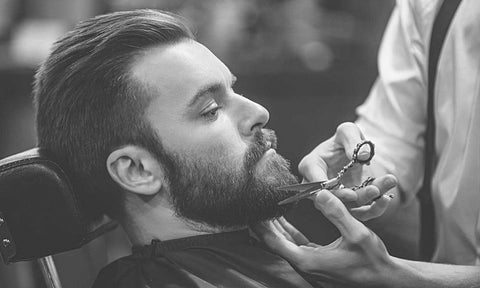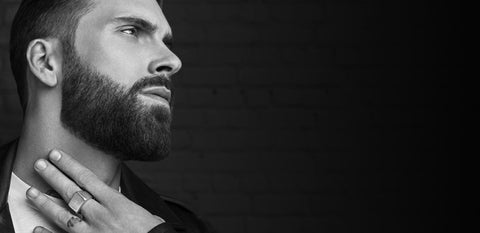Your Cart is Empty
⭐️ free shipping on orders over $75 ⭐️
⭐️ free shipping on orders over $75 ⭐️
Ensuring that your facial hair consistently looks flawless doesn't come easy. That barely qualifies as news, yet it's a point worth stressing on the chance that you like to adopt a do-it-yourself strategy for trimming and shaping your whiskers.
If you do, we have your back. This article will guide you through the most proficient method to shape your beard. We'll consider every contingency, from cutting the various areas of your beard to choosing what facial hair styles suit your face shape. We've included a lot of info and advice from the experts.
TRIMMING YOUR NECKLINE IN 5 EASY STEPS
There is no right or wrong way to trim a neckline. It’s right that you don’t want to trim it without any forethought, but the fine-tuning of it is up to you. So is the height of your neckline, which is an important consideration. I start off trimming a small amount first because you can always trim more later if you feel you need it, but trim too much and you'll be kicking yourself that you'l have to wait for it to grow back in.
What’s important to remember, is that a bad neckline can ruin the overall look of a beard you’ve worked so hard to grow. And while some men prefer just to let their neckline grow, (ie. Canadian lumberjack style) others like a neat and tidy neckline that enhances their beard’s shape and therefore appearance.
With some basic technique and rules, you can shape a beard neckline like a professional while enhancing the overall look of your facial hair. Let’s dig deeper.
The first, most important step of shaping a neckline is defining it and determining the height and depth of your neckline. It will vary depending on your personal preference and the overall look of your beard, but here are a couple of tried-and-true methods for defining a neckline:-

A hockey player never steps on the ice armed with a broom stick, and a carpenter doesn’t use a hammer when he needs a saw. The same principle holds true for trimming your neckline: you need the proper tools, such as beard trimmers, clippers, scissors and even a razor if you want a clean looking neck.
Again, how high or low you trim your neckline is a matter of personal preference, but keep in mind that trimming too high may cause you to lose some of the mass and perceived thickness of your beard. It can also make your face appear too big for your beard.
After you’ve shaved off the excess hair that grows beneath your defined neckline, even as far down as the chest for some men, you’ll want to hold your trimmers at an angle and use an upward motion to shape the neckline. You might prefer to keep the thickness of your neck hair shorter than your beard, even up to two length settings shorter.
If you want to get a subtle, natural finish to your neckline, a fade is the way to go. A gradual fade creates a change in the thickness of the hairline from the bottom of your neckline up to where your beard is thickest, likely on your chin. For the fade style, the maximum length of your beard should be on your cheeks while the shorter hair is on your neck.
You’ll want to set the trimmer’s length setting about two notches lower than the setting you use for the hair on your cheeks. Use an even shorter setting, if you need, on the very bottom section of your neckline, then increase the length as you move towards your chin.
One of the good things about a fade is that it provides a tapered finish that helps enhance your beard’s overall look. To create a clean finished appearance, make sure to shave off the stubble on your neck below the neckline.
In general, men with big beards have less work to do when creating a fade because the neckline isn’t as noticeable as it is with short beards. A neckline that’s too short stands out for all the wrong reasons when you have a long beard.

There is a lot to like about short beards, when trimmed and shaped correctly, shorter beards can look really cool on most guys. They usually require less maintenance than longer beards and may be more suitable for certain professions. Here are some steps you can take everyday to keep your short beard looking sharp.
We’ve already covered this, but one key point deserves emphasizing. That is, always be careful not to trim your neckline too high. It draws attention to the underside of your neck and tends to highlight any extra loose skin.
Remember, stick to the two-finger method for defining your neckline—it will help keep you from trimming too high. You also want to keep your neckline symmetrical, which makes it easier to shave and trim to the right place.
USING A BEARD TRIMMER
Trimmers come with guards and length settings to make it easier to style any length of beard. Use a longer guard for less hair removal during the early stages of shaping a short beard. Then take a little off each side of your face, switching from one side to the other until you’ve achieved an overall even, symmetrical look.
Defining your cheek line is another important part of the process when shaping a short beard. One way to set your cheek line is to smile into a mirror and follow the line of your smile up to the sideburns. Once you have the outline of your cheek line, use a straight or safety razor to get rid of the excess hair above your cheek line to create a sharp line.
A beard trimmer is also effective for creating a good cheek line, however you can use your index finger to define exactly where you want the line to be. Doing this helps you to create a more even line when you’re not using a razor.
Maintaining a neat cheek line, like the neckline, is an important part of creating a professional-looking beard. A beard that’s not lined up properly around the cheek line can make it look unfinished.
While a neckline that’s too high can spoil the look of a beard, a cheek line that’s too low represents another aesthetic issue. Let’s take a closer look at how to shape a beard cheek line properly.
Following steps in a certain order when trimming your beard, and shaping a short beard can make things easier. Here’s what we suggest:
The most important rule for trimming your beard, whether it’s short, long, or in between, is to not take off too much too soon. Of course, that applies to most beard grooming tools because you can’t put back what you’ve already taken off. Go easy! Especially at the start, only take off more if your beard and its style demand it.
Comb against the grain to get the whiskers to stand up, this makes it easier to trim with scissors. Carefully work your way up the sides of your beard while paying close attention to the symmetry of your beard.
A square shape is a nice small to midsize beard in which the sides are going to go straight down. There’s nothing overly complicated about it, but it gives your whiskers a nice, fresh look with clear, sharp lines.
To shape a square beard, you’ll want to start with the sides and sharpen the line that extends down from near the ear to the jawline and beyond. Brush the beard down before you begin to trim it and then use a detailer —a type of clipper that’s typically lightweight and made for smaller jobs in which maneuverability and finesse come in handy.
Use your detailer to sharpen the angles, to tighten the borderline of your cheeks, and get rid of any strays that can detract from a tight, uniform look. Follow a line straight down from the ears to get a “box” finish that’s a distinctive characteristic of the square beard.
You’ll want to make sure to keep the line straight down to the neck, keeping the overall shape as square as possible. You can comb it out again near the bottom of the beard and then square it off under the jawline. Don’t round it off, but instead keep those edges sharp.
Trim away excess neck hair up to your defined neckline. Then, shave the excess hair above the cheek line to keep it tidy. You should monitor it closely because it's an area in which hair grows back quickly, it’s likely you’ll need to trim it again in a few days.
A razor is the best tool to use for cleaning up around the cheek line, whether it’s a straight razor, cartridge razor, safety razor, etc. Keep the skin slightly taut to help you get a close shave.
You can use your clippers, just the corner of them, to trim the excess moustache hair around your upper lip and at the corners of your mouth.

Something else to keep in mind about shorter beards is that they’ll stand out more than long beards if you don’t maintain them properly. Paying attention to the shape of your face will define the form of your short beard.
Generally speaking, there are seven basic face shapes:
Next, we’ll go over the best beard styles for your face shape.
We’ve established the importance of choosing a shape and style of beard that best suits your face shape. It’s not something you want to overlook if you want to rock a beard full of confidence. Let’s take some time to look at how it should all fit together seamlessly.
Oval Face ShapeRound at both the top and bottom but also slightly long without too much jawline definition, an oval face is the most common shape and one that can handle a wide variety of beard styles. It’s important to be consistent with your beard’s length at every area while keeping stray hairs from bursting out and marring the overall look.
Not to overly emphasize the point, but oval-faced gents have plenty of advantages when growing a beard and they’re free to try most styles without the fear of looking clownish.
Square Face ShapeBeard styles that typically look best with square faces are those that feature more hair on the chin and a bit less on the sides and neck. If you fall into this category, make sure to carefully monitor your neckline to keep it looking tidy. Your focus is to keep hair from becoming too full on the cheeks and sideburns, which can create a look that’s blocky and squared-off. Whether it’s a full goatee, an Anchor beard, a Balboa beard, or chinstrap, you can find plenty of styles to fit your square face shape.
Round Face ShapeA round face features a softer jawline which extends to a hairline that’s more rounded than on other face shapes. You also have a jawline that’s less pointed than on men with other face shapes.
So, what beard shapes work best with round faces? For starters, choose a style that’s shorter on the sides and longer on the bottom. Keep your sideburns and cheeks in check, and it’s OK if you leave your whiskers a bit longer on your chin and neck.
Beard styles such as goatees and chinstraps fit well on round faces, but you have plenty of other options as long as you keep your beard maintained properly. Also, a triangular-shaped style works well with a rounded face shape.
Diamond Face ShapeCheekbones represent the prominent feature on a diamond-shaped face. The goal with growing and shaping a beard with this face shape should be to keep some hair on the chin to offset the cheekbones. It’s advisable to create a square shape on the chin, while not letting your whiskers get too long. Keep the hair on your chin from getting too pointy or it will make your face shape more prominent than you may prefer.
Triangular Face ShapeOn the flip side of a diamond face lies the triangular face. For this face shape it’s best to take attention away from the prominent chin. One look that you can rock with a triangular face is a stubble beard with a mustache This style helps draw attention to the upper areas of your face. You’ll want to avoid anything too full on your cheeks because it will make your jawline seem even wider.
Oblong Face ShapeAn oblong face shape, also referred to as a long face, is well-suited for beard shapes that are full on the sides and shorter on the bottom. Feel free to grow out your sideburns and the hair on your cheeks a bit more while keeping the neck clean and well-maintained. You can try a full beard, goatee, and Mutton Chops on an oblong face.
Heart-Shaped FaceFull beards work especially well on heart-shaped faces because they help give a more angular look. The extra bulk also helps fill out a weak chin and widens the jawline.
KEEP IT IN TIP-TOP SHAPE

Letting your beard grow from its humble beginnings into a great-looking long beard requires some maintenance along the way. And once it reaches the length you desire, its maintenance needs don’t subside—far from it.
It takes the right techniques and tools to shape a long beard the right way, as well as a consistent approach that includes the following tips and suggestions.

An important point to remember when trimming a beard is that your neckline and jawline are not the same thing. While this may seem obvious, many men have made the mistake of trimming their neckline too high or they trim their jawline too short because of it, which creates the appearance of a shrunken beard that’s too small for their face. And that’s not a good look on anyone.
A properly-maintained jawline gives you a strong, masculine look. While your natural jawline, without whiskers, may not be as chiseled as Brad Pitt', you can make it appear that way with some crafty trimming techniques that help shape a beard jawline.
You start by defining the strong angles of your beard while ensuring that your beard accentuates the angle of your jaw near your ears. Opt for a shorter fade on your neckline to enhance the look. The goal is to create more weight in the right areas of the beard that help give your jawline a chiseled look.
It can be easy to forget about these areas as you concentrate on the larger parts of your facial hair, such as around the cheeks and neck. But hair that’s allowed to grow too long near the ears detracts from the otherwise magnificent parts of your facial grooming and it’s a mistake you should avoid.
The best way to get your sideburns looking their best, blending in well with the rest of your beard, is to use a comb and clippers to taper them. Start at the bridge between your hairline and take off a little bit of hair. We’ll say it again, go easy! You can always take off more later, if needed, until you find a length that’s acceptable and blends well with the thickest part of your beard. With a bit of practice, you’ll learn how to taper your sideburns like a pro and you’ll love how it enhances your beard’s overall appearance.
Your moustache deserves attention too. While bushy ‘taches work well for some men, they can look scraggly and out of control on the rest of us, detracting from a beard’s look and our grooming efforts.
A fundamental task of moustache trimming is to trim the hair that droops into your mouth. It’s not a good look, and considering the amount of food and drink that excess hair attracts, it’s not all that sanitary, either. Use scissors to handle that basic, but essential, step.
Now that we’ve covered the basics of trimming the various areas for your beard, from your neckline to your sideburns, here are some general hints that will help reinforce the information so you feel confident to handle the job on your own:
Always comb out the beard first – Use a fine-toothed beard comb, or even a brush, while stroking the hair outward so that the hair stands up in one direction. Doing so gives you a better sense of the length of your beard while making it easier to snip off the strays.
Comb daily – Combing your facial hair every day not only helps you to identify the areas that need trimming, but also prevents knots and tangles, redistributes the natural oils of your skin down the hair follicle (as well as beard oil, which you should also use frequently), and trains the hairs in the direction you want it to lay.
Brushing your beard – Keeping your beard well-brushed is a useful way to give it the appearance of added volume, as well as some of the same benefits as combing.
Whatever you do… – Don’t leave the underside of your chin bare. Unless, that is, you prefer the look of a double chin, even if you don’t have one. You’ll give yourself a “chinstrap” look that you may not want.
Take a little off at the start – Use your beard trimmer to control how much you take off when shaping and trimming your beard. That means applying light pressure, using upward strokes if your goal is to thin out a bushy beard. Use downward strokes if you’d rather not take off so much.
Work from the outside in – It’s usually best to start at your cheeks and work your way to areas such as your chin, neckline, and moustache. Make sure you find the right balance between tidiness and volume before you concentrate on the “finer” points.
Create a transition with your sideburns – Sideburns are either, A) an extension of your beard, or B) an extension of your head hair. Either way, if your scalp hair and beard hair are approximately the same length, then you want your sideburns to flow seamlessly into both. If one is a lot longer than the other, fading your sideburns using smaller guards on your trimmer is a good strategy.
We’ve spent a lot of time talking about how to shape your beard and neckline and, along the way, we’ve mentioned some of the tools you’ll need to do the job right. We think it’s worth it to take a brief look at why you’ll need them.
Mirror – If you’re going to make trimming your beard a DIY project you must have a mirror. The reasons why are pretty obvious and, unless you want to gamble on everything (including how your beard will look after trimming it sans mirror) don’t start shaping your beard without being able to clearly see what you’re doing.
Beard Brush & Comb – A quality boar’s hair Beard Brush and a Beard Comb are essential components of any beardsmen’s Grooming Kit. These tools help to detangle your beard and get your beard ready for grooming. Plus it enhances its appearance. Whatever you do, don’t cheap out and buy a low-quality brush or comb. They can cause issues like hair that’s more prone to breakage, split ends, frizziness, and a less-than-stellar appearance.
Beard Scissors – A good pair of scissors are essential for trimming and detailing your beard. You’ll want a pair with a balanced feel and high quality components, which contributes to more control in your hands when you’re using them.
Razors – Beard trimmers and clippers are handy for shaping your beard, perhaps the handiest tools of all, but many men prefer using razors, at least for some aspects of the job. And there are plenty of options to choose from, including safety razors, cartridge razors, electric razors, and straight razors.
Beard Shaping Guide – Beard shapers, as we touched on earlier, are great for defining your neckline, but also for creating a wide variety of beard styles that you have to choose from.
The Hydrators – Let’s not forget about Beard Oil and beard balm. Each one of them serves a variety of functions and are great for the overall health and appearance of your beard (and the skin underneath). They make the job of trimming and shaping your beard much easier!
You can learn what the best oils for your beard are in our article: What are the best 5 oils for a full beard
Or you can learn what the heck beard oil does in our article: What does beard oil do??
That wraps up our look at how to shape your beard to ensure you always look and feel your best. We hope these tips and suggestions help you to handle the heavy lifting of trimming your beard at home. There’s certainly nothing wrong with visiting a professional barber, and we strongly encourage it if that’s your preference, but you should be able to get the beard shape you want at home with close and careful execution.
